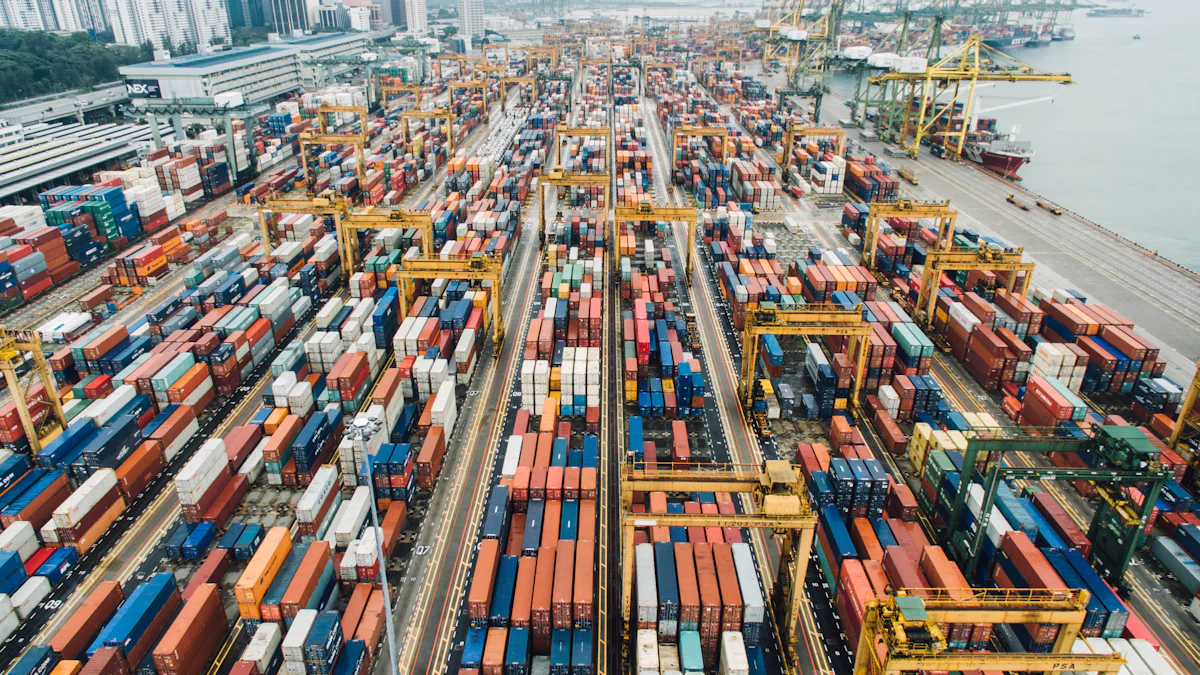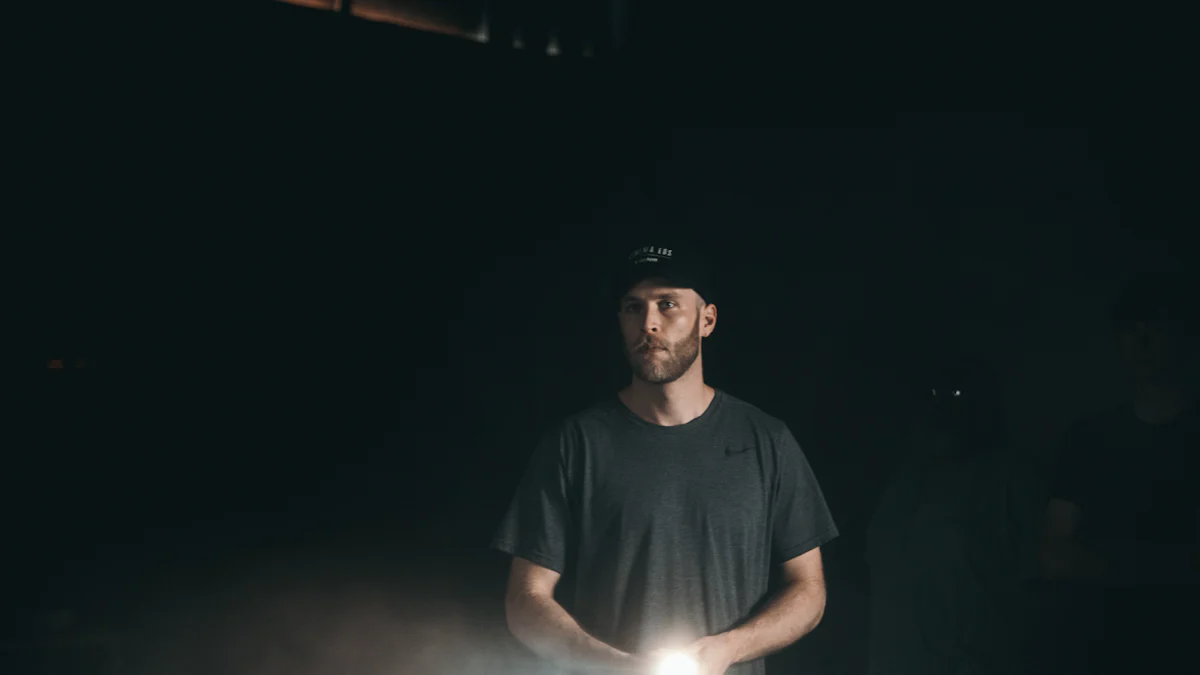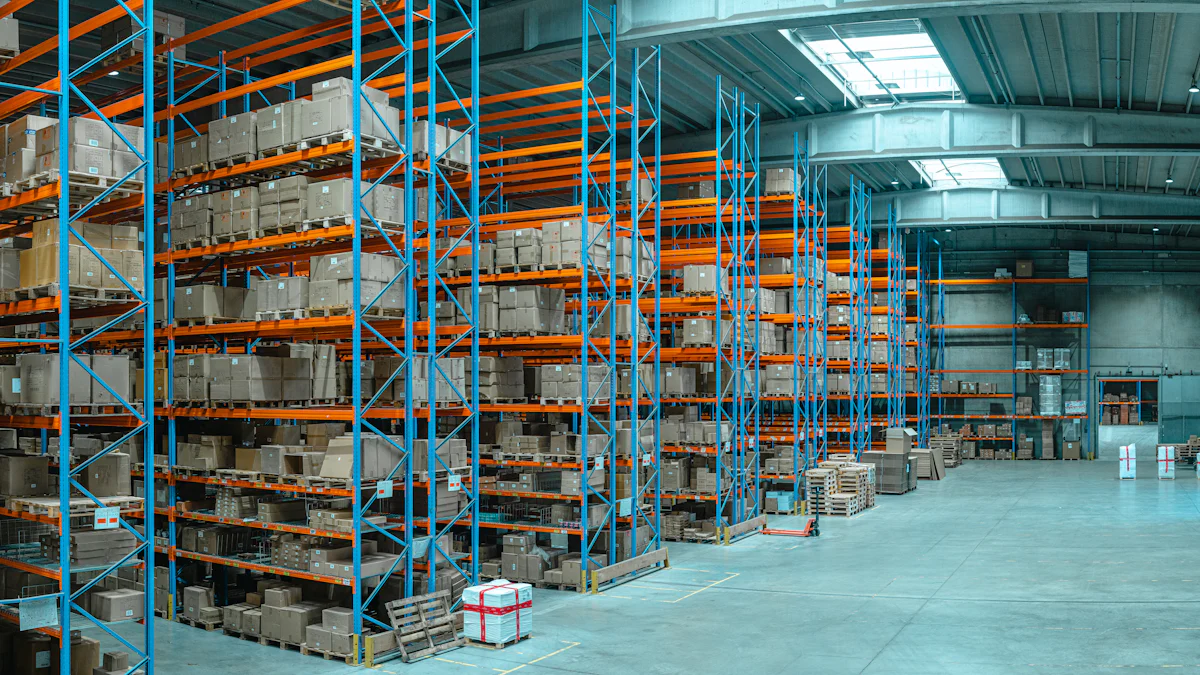The Bright Path Ahead for Flashlight Supply Chains

Flashlight production plays a vital role in modern life. You rely on these tools for safety, convenience, and emergencies. In 2025, advancements in technology are reshaping how flashlights are made and used. Sensor-based controls and long-lasting batteries improve functionality. Solar-powered and USB-rechargeable designs reduce environmental impact. Materials like aerospace-grade aluminum and impact-resistant polymers make flashlights more durable. These trends not only enhance performance but also address sustainability. As you explore the future of flashlight technology, you’ll see how innovation continues to meet evolving needs.
Key Takeaways
Flashlights are improving with better LED lights, making them brighter.
Smart flashlights now have app control and voice commands for ease.
Eco-friendly flashlights, like solar and rechargeable ones, cut down waste.
Custom flashlight designs help different jobs by meeting specific needs.
Strong supply chains are key; using more suppliers and tech helps avoid issues.
Technological Advancements in Flashlight Production

LED Technology Transformations
Energy efficiency and cost reduction
You’ve likely noticed how flashlights have become more efficient over the years. Advancements in LED technology have played a major role in this transformation. LEDs consume far less power than traditional incandescent bulbs. This reduces energy costs and extends battery life. With these improvements, you can rely on your flashlight for longer periods without frequent recharging or battery replacements.
Here’s a quick look at how LEDs are changing flashlight performance:
Advancement Type | Description |
|---|---|
Consumes significantly less power, reducing costs and environmental impact. | |
Durability and Longevity | Designed to last longer, minimizing the need for replacements. |
Eco-friendly Impact | Reduces energy consumption and carbon emissions, supporting sustainability. |
Smart Technology | Includes USB charging and app control for enhanced usability. |
Enhanced brightness and durability
Modern LEDs deliver brighter and more focused lighting. This ensures better visibility in low-light conditions. They also withstand rough handling, making them ideal for outdoor adventures or professional use. You’ll find that these advancements improve both the reliability and durability of flashlights.
Smart Flashlights and AI Features
Integration of voice control and app connectivity
New technologies are making flashlights smarter than ever. Many now feature Bluetooth connectivity, allowing you to control brightness levels or switch modes through a smartphone app. Some models even include geolocation tracking, so you can locate your flashlight if it’s misplaced. USB charging and built-in sensors add to their convenience. These features make smart flashlights a valuable tool for both everyday users and professionals.
AI-driven user customization
AI technology takes customization to the next level. Smart flashlights can now adapt to your preferences. For example, they can automatically adjust lighting intensity based on your environment. This ensures optimal lighting without manual adjustments. These innovations enhance usability and make flashlights more intuitive.
Innovations in Materials and Design
Lightweight, durable, and eco-friendly materials
Flashlights today use materials like aerospace-grade aluminum and impact-resistant polymers. These materials make them lightweight yet durable. You’ll also find eco-friendly options that reduce environmental impact. This combination of strength and sustainability ensures that your flashlight can handle tough conditions while being environmentally responsible.
Waterproof and shockproof advancements
Modern designs focus on durability. Waterproof and shockproof features protect flashlights from damage in harsh environments. Whether you’re hiking in the rain or working in rugged conditions, these advancements ensure your flashlight remains functional.
Sustainability and Environmental Impact in Flashlight Production

Eco-Friendly Power Solutions
Rechargeable and solar-powered flashlights
You can now choose flashlights that rely on sustainable power solutions like rechargeable and solar-powered options. These eco-friendly solutions eliminate the need for disposable batteries, which often end up in landfills. Solar-powered flashlights use renewable energy, reducing carbon emissions and dependence on non-renewable resources.
Here are some environmental benefits of these lighting innovations:
Solar rechargeable flashlights lower electronic waste by removing the need for constant battery purchases.
They help conserve fossil fuels and align with sustainable practices.
By using renewable energy, they contribute to environmental conservation efforts.
Reducing dependency on disposable batteries
Disposable batteries create significant waste and environmental harm. Rechargeable flashlights reduce this dependency, offering a more sustainable choice. You can recharge these devices multiple times, cutting down on waste and saving money. This shift supports sustainability while ensuring reliable lighting for your needs.
Recycling and Circular Economy Practices
Challenges in recycling flashlight components
Recycling flashlight components presents unique challenges. Manufacturers must understand the design and functioning of each part. Without proper recycling systems, production may slow or even stop. Additionally, improper handling of materials can harm workers and the environment.
Opportunities for sustainable production models
To address these challenges, companies are developing tailored recycling systems. These systems optimize material recovery and ensure safety. Workers receive training to operate and maintain these systems effectively. By adopting these practices, manufacturers can create a circular economy, where materials are reused instead of discarded. This approach promotes eco-friendly solutions and reduces waste.
Regulatory Compliance and Industry Standards
Adapting to global environmental regulations
Environmental regulations are becoming stricter worldwide. You’ll notice that flashlight manufacturers are adapting by using sustainable materials and processes. These changes help companies meet legal requirements while reducing their environmental footprint.
Meeting consumer expectations for sustainability
Consumers like you increasingly demand sustainable products. Flashlight makers are responding by offering eco-friendly designs and packaging. These efforts align with your values and contribute to a greener future. By choosing these products, you support sustainability and encourage further innovation in the industry.
Market Trends and Consumer Preferences for Flashlights
Demand for Multi-Functional Flashlights
Hybrid devices like flashlight-power banks
You’ve likely noticed the growing popularity of hybrid flashlights that double as power banks. These devices provide both reliable lighting and the ability to charge your electronic devices. They are especially useful during outdoor adventures or emergencies when access to electricity is limited. By combining two essential tools into one, these flashlights offer convenience and practicality. This trend reflects the increasing demand for multi-functional products in the flashlight market.
Flashlights with built-in tools and features
Modern flashlights now come equipped with additional tools to enhance their functionality. Some models include built-in compasses, emergency whistles, or even glass-breaking tips for safety. These features make them ideal for outdoor enthusiasts and professionals alike. You’ll find that these innovations cater to the growing need for versatile lighting solutions that go beyond basic illumination.
Customization and Personalization in the Market
Tailored designs for specific industries
Flashlight manufacturers are creating designs tailored to meet the needs of specific industries. For example, construction workers often require rugged, high-lumen flashlights that can withstand harsh conditions. Medical professionals may prefer compact, lightweight models with adjustable brightness for precision tasks. These tailored solutions ensure that you get a flashlight designed specifically for your unique requirements.
The role of 3D printing in customization
Advances in 3D printing technology are revolutionizing the flashlight market. This technology allows manufacturers to produce custom designs quickly and cost-effectively. You can now order flashlights with personalized features, such as engraved names or unique shapes. This level of customization appeals to consumers seeking products that reflect their individuality or specific needs.
Emerging Consumer Segments
Growth in outdoor and adventure markets
The outdoor and adventure market is experiencing significant growth. More people are participating in activities like camping, hiking, and fishing. This has increased the demand for portable and reliable lighting solutions. Flashlights with advanced LED technology, rechargeable batteries, and durable designs are becoming essential for outdoor enthusiasts. These trends highlight how consumer behavior is shaping the flashlight market.
Increased demand from industrial and professional users
Industrial and professional users are also driving demand for high-performance flashlights. Sectors like construction, mining, and law enforcement require durable and efficient lighting tools. Innovations in flashlight design, such as waterproof and shockproof features, meet the rigorous demands of these industries. As a result, the flashlight market continues to expand to serve these specialized needs.
Supply Chain Challenges and Solutions in Flashlight Production
Global Disruptions and Risks
Impact of geopolitical tensions on raw materials
Geopolitical tensions create significant risks for flashlight production. Sanctions and export controls often restrict access to essential materials. For example, political conflicts can disrupt the flow of rare earth metals used in LED manufacturing. Compliance issues also arise when countries like China and Russia enforce differing regulations. These challenges complicate supply chain management and increase costs. Recent laws, such as the Uyghur Forced Labor Prevention Act, further impact supply chains by limiting materials sourced from specific regions. Economic restrictions between major trading partners, like the U.S. and China, add another layer of uncertainty.
Navigating shipping delays and logistical issues
Shipping delays have become a common hurdle in flashlight production. Port congestion, labor shortages, and rising fuel costs slow down the movement of goods. These delays disrupt manufacturing schedules and lead to inventory shortages. You may notice longer wait times for new flashlight models or higher prices due to increased shipping costs. Companies are now investing in advanced logistics systems to track shipments in real time. This helps them respond quickly to disruptions and minimize delays.
Building Resilient Supply Chains
Diversifying suppliers and production locations
Diversifying suppliers is a key strategy for reducing risks in flashlight production. Many companies are expanding their supplier base to avoid over-reliance on a single source. In fact, 77% of businesses plan to increase their number of suppliers within the next two years. Some manufacturers are also exploring emerging markets for innovation and production. For example, Apple’s approach to securing multiple suppliers for memory chips demonstrates how diversification can strengthen supply chains. By adopting similar strategies, flashlight manufacturers can ensure a steady supply of materials and reduce vulnerabilities.
Leveraging technology for real-time monitoring
Technology plays a vital role in building resilient supply chains. Real-time monitoring systems allow you to track every stage of production and delivery. These tools provide valuable insights into potential disruptions, such as delays or material shortages. Manufacturers can use this data to make informed decisions and adjust their operations quickly. Advanced analytics also help identify inefficiencies, enabling companies to optimize their supply chains. This ensures that flashlights reach you on time and at a reasonable cost.
Cost Management and Efficiency
Balancing affordability with quality
Balancing affordability with quality remains a challenge in flashlight production. Manufacturers must keep costs low while maintaining high standards. Using advanced materials like aerospace-grade aluminum helps improve durability without significantly increasing expenses. Streamlined production processes also reduce costs, ensuring that you get reliable flashlights at competitive prices. Companies that prioritize efficiency can offer affordable products without compromising on performance.
Streamlining production to reduce waste
Reducing waste is essential for both cost management and sustainability. Manufacturers are adopting lean production methods to minimize material waste and energy consumption. For example, recycling leftover materials from the production process helps lower costs and supports environmental goals. These practices not only make flashlight production more efficient but also align with your growing demand for eco-friendly products.
The Future of Flashlight Technology and Opportunities
Emerging Markets and Applications
Growth in regions with limited electricity access
Flashlights are becoming essential in regions where electricity access remains limited. Advancements in LED technology make these devices more energy-efficient and affordable. Rechargeable flashlights are gaining popularity because they eliminate the need for disposable batteries. This reduces costs and waste. Outdoor activities like camping and hiking are also driving demand for reliable lighting solutions in these areas.
You’ll see companies expanding into emerging markets to meet this growing need. Many are developing innovative and multifunctional flashlights tailored for these regions. Strategic partnerships with e-commerce platforms help manufacturers reach more consumers. These efforts ensure that people in underserved areas can access dependable lighting tools.
Expanding use in healthcare and emergency services
Flashlights are playing a critical role in healthcare and emergency services. Medical professionals rely on compact, high-intensity lighting for precision tasks. Emergency responders use durable, waterproof models during rescue operations. These specialized designs improve efficiency and safety in challenging environments. As the future of flashlight technology evolves, you’ll notice more tailored solutions for these vital sectors.
Integration with IoT and Smart Ecosystems
Flashlights as part of connected home systems
Smart homes are transforming how you interact with everyday devices, including flashlights. Many models now feature Bluetooth connectivity, allowing you to control brightness and modes remotely. Some even include geolocation tracking, so you can locate your flashlight if misplaced. These integrations make flashlights a seamless part of your connected lifestyle.
Industrial IoT applications for flashlights
In industrial settings, IoT-enabled flashlights are enhancing productivity. For example, work lights with Bluetooth speakers provide both illumination and communication tools. Adventure lights that sync with music adjust brightness dynamically, creating a unique experience. These innovations demonstrate how IoT is shaping the future of flashlight technology.
Innovation as a Driver of Growth
The role of R&D in shaping the future
Research and development drive progress in flashlight technology. Companies invest heavily in creating brighter, more efficient lighting solutions. Lightweight materials and advanced batteries are just a few examples of how R&D improves performance. These innovations ensure that flashlights continue to meet your evolving needs.
Collaboration between manufacturers and tech companies
Partnerships between flashlight manufacturers and tech companies are unlocking new possibilities. By combining expertise, they develop cutting-edge features like AI-driven customization and IoT integration. These collaborations accelerate innovation and bring you smarter, more versatile lighting tools.
The flashlight industry is evolving rapidly, driven by exciting trends in technology, sustainability, and consumer demand. You’ve seen how advancements like smart features, eco-friendly designs, and durable materials are shaping the future. Challenges such as supply chain disruptions and environmental concerns highlight the need for adaptable strategies. By focusing on innovation and sustainable practices, businesses can overcome these hurdles and seize new opportunities. Investing in future-ready solutions ensures you stay ahead in this dynamic market while meeting the growing expectations of consumers.
FAQ
What makes LED flashlights more efficient than traditional ones?
LED flashlights consume less energy and last longer. They produce brighter light while using minimal power. This efficiency reduces battery usage and environmental impact. You’ll also notice that LEDs generate less heat, making them safer and more reliable for extended use.
How do rechargeable flashlights benefit the environment?
Rechargeable flashlights eliminate the need for disposable batteries. This reduces electronic waste and prevents harmful chemicals from polluting the environment. By recharging your flashlight, you save money and contribute to sustainability efforts. It’s an eco-friendly choice that aligns with modern environmental values.
Can smart flashlights work without an internet connection?
Yes, most smart flashlights function offline. Features like brightness adjustment and mode switching work without connectivity. However, advanced options like app integration or geolocation tracking may require internet access. You can still rely on basic functions in areas without a network.
Are solar-powered flashlights reliable in low-sunlight regions?
Solar-powered flashlights store energy in built-in batteries. Even in low-sunlight regions, they can provide reliable lighting after charging. Many models also include USB charging as a backup option. This ensures you always have access to light, regardless of weather conditions.
What industries benefit most from customized flashlights?
Industries like construction, healthcare, and law enforcement benefit greatly from customized flashlights. Rugged designs suit construction sites, while compact models with adjustable brightness help medical professionals. Law enforcement relies on durable, high-lumen flashlights for safety. Tailored designs meet the unique needs of these sectors effectively.
See Also
Navigating the 2024 Flashlight Industry: Insights and Trends
Boosting Revenue: Finding the Best Flashlight Wholesalers
Assessing Flashlight Vendors: Essential Factors and Developments
Overcoming Challenges: My Journey to Trusted Flashlight Suppliers
Building Alliances with Flashlight Wholesalers: A Retailer’s Handbook
About US
Follow Us
Hello,Friend,
I am Mary from Helius, we are manufacturer of LED lighting products with more than a decade of experiences.
We offer hot selling products in market and guarantee the quality with competitive cost.
Let’s have more discussion on your inquiry.
Or you can reach out me via what’s up/tele gram +8618123952945 if it’s favorable to you.
Address
4th Floor, Building A16, Intelligent terminal industrial park of Silicon Valley, Dafu Industrial Zone,Guanlan, Shenzhen, 518110 China
Contacts
mary@heliuslights.com
heliuslight04@hotmail.com
+0086 18123952945
